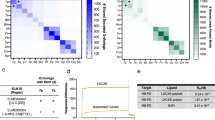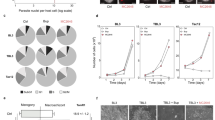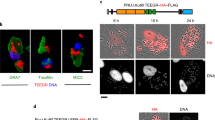Abstract
Complex links between infection and cancer suggest that we still can learn much about tumorigenesis by studying how infectious agents hijack the host cell machinery. We studied the effects of an intracellular parasite called Theileria that infects bovine leukocytes and turns them into invasive cancer-like cells. We investigated the host cells pathways that are deregulated in infected leukocytes and might link infection and lymphoproliferative disease. We show that intracellular Theileria parasites drive a Warburg-like phenotype in infected host leukocytes, characterized by increased expression of metabolic regulators, increased glucose uptake and elevated lactate production, which were lost when the parasite was eliminated. The cohabitation of the parasites within the host cells leads to disruption of the redox balance (as measured by reduced/oxidized glutathione ratio) and elevated ROS (reactive oxygen species) levels, associated with chronic stabilization of the hypoxia-inducible factor 1 alpha (HIF1α). Inhibition of HIF1α (pharmacologically or genetically), or treatment with antioxidants, led to a marked reduction in expression of aerobic glycolytic genes and inhibited the transformed phenotype. These data show that stabilization of HIF1α, following increased ROS production, modulates host glucose metabolism and is critical for parasite-induced transformation. Our study expands knowledge about the molecular strategy used by the parasite Theileria to induce the transformed phenotypes of infected cells via reprogramming of glucose metabolism and redox signaling.
This is a preview of subscription content, access via your institution
Access options
Subscribe to this journal
Receive 50 print issues and online access
$259.00 per year
only $5.18 per issue
Buy this article
- Purchase on Springer Link
- Instant access to full article PDF
Prices may be subject to local taxes which are calculated during checkout







Similar content being viewed by others
References
Chaussepied M, Langsley G . Theileria transformation of bovine leukocytes: a parasite model for the study of lymphoproliferation. Res Immunol 1996; 147: 127–138.
Dobbelaere D, Heussler V . Transformation of leukocytes by Theileria parva and T. annulata. Annu Rev Microbiol 1999; 53: 1–42.
Lizundia R, Chaussepied M, Huerre M, Werling D, Di Santo JP, Langsley G . c-Jun NH2-terminal kinase/c-Jun signaling promotes survival and metastasis of B lymphocytes transformed by Theileria. Cancer Res 2006; 66: 6105–6110.
Chaussepied M, Janski N, Baumgartner M, Lizundia R, Jensen K, Weir W et al. TGF-b2 induction regulates invasiveness of Theileria-transformed leukocytes and disease susceptibility. PLoS Pathog 2010; 6: e1001197.
Somerville RP, Adamson RE, Brown CG, Hall FR . Metastasis of Theileria annulata macroschizont-infected cells in scid mice is mediated by matrix metalloproteinases. Parasitology 1998; 116 (Pt 3): 223–228.
Dobbelaere DA, Coquerelle TM, Roditi IJ, Eichhorn M, Williams RO . Theileria parva infection induces autocrine growth of bovine lymphocytes. Proc Natl Acad Sci USA 1988; 85: 4730–4734.
Muraguri GR, Kiara HK, McHardy N . Treatment of East Coast fever: a comparison of parvaquone and buparvaquone. Vet Parasitol 1999; 87: 25–37.
Galley Y, Hagens G, Glaser I, Davis W, Eichhorn M, Dobbelaere D . Jun NH2-terminal kinase is constitutively activated in T cells transformed by the intracellular parasite Theileria parva. Proc Natl Acad Sci USA 1997; 94: 5119–5124.
Chaussepied M, Lallemand D, Moreau MF, Adamson R, Hall R, Langsley G . Upregulation of Jun and Fos family members and permanent JNK activity lead to constitutive AP-1 activation in Theileria-transformed leukocytes. Mol Biochem Parasitol 1998; 94: 215–226.
Dessauge F, Hilaly S, Baumgartner M, Blumen B, Werling D, Langsley G . c-Myc activation by Theileria parasites promotes survival of infected B-lymphocytes. Oncogene 2004; 24: 1075–1083.
Mentis AF, Kararizou E . Metabolism and cancer: an up-to-date review of a mutual connection. Asian Pac J Cancer Prev 2010; 11: 1437–1444.
Seyfried TN, Shelton LM . Cancer as a metabolic disease. Nutr Metab (Lond) 2010; 7: 7.
Koppenol WH, Bounds PL, Dang CV . Otto Warburg's contributions to current concepts of cancer metabolism. Nat Rev Cancer 2011; 11: 325–337.
Warburg O . On the origin of cancer cells. Science 1956; 123: 309–314.
Yeung SJ, Pan J, Lee MH . Roles of p53, MYC and HIF-1 in regulating glycolysis - the seventh hallmark of cancer. Cell Mol Life Sci 2008; 65: 3981–3999.
Gatenby RA, Gillies RJ . Why do cancers have high aerobic glycolysis? Nat Rev Cancer 2004; 4: 891–899.
Wenger RH, Stiehl DP, Camenisch G . Integration of oxygen signaling at the consensus HRE. Sci STKE 2005; 2005: re12.
Vander Heiden MG, Cantley LC, Thompson CB . Understanding the Warburg effect: the metabolic requirements of cell proliferation. Science 2009; 324: 1029–1033.
Semenza GL . HIF-1 mediates the Warburg effect in clear cell renal carcinoma. J Bioenerg Biomembr 2007; 39: 231–234.
Favier J, Briere JJ, Burnichon N, Riviere J, Vescovo L, Benit P et al. The Warburg effect is genetically determined in inherited pheochromocytomas. PLoS One 2009; 4: e7094.
Dang CV, Semenza GL . Oncogenic alterations of metabolism. Trends Biochem Sci 1999; 24: 68–72.
Denko NC . Hypoxia, HIF1 and glucose metabolism in the solid tumour. Nat Rev Cancer 2008; 8: 705–713.
Semenza GL . Targeting HIF-1 for cancer therapy. Nat Rev Cancer 2003; 3: 721–732.
Theilen GH, Rush JD, Nelson-Rees WA, Dungworth DL, Munn RJ, Switzer JW . Bovine leukemia: establishment and morphologic characterization of continuous cell suspension culture, BL-1. J Natl Cancer Inst 1968; 40: 737–749.
Gillies RJ, Robey I, Gatenby RA . Causes and consequences of increased glucose metabolism of cancers. J Nucl Med 2008; 49 (Suppl 2): 24S–42S.
Shaw RJ . Glucose metabolism and cancer. Curr Opin Cell Biol 2006; 18: 598–608.
Zhang H, Qian DZ, Tan YS, Lee K, Gao P, Ren YR et al. Digoxin and other cardiac glycosides inhibit HIF-1alpha synthesis and block tumor growth. Proc Natl Acad Sci USA 2008; 105: 19579–19586.
Jaakkola P, Mole DR, Tian YM, Wilson MI, Gielbert J, Gaskell SJ et al. Targeting of HIF-alpha to the von Hippel-Lindau ubiquitylation complex by O2-regulated prolyl hydroxylation. Science 2001; 292: 468–472.
Masella R, Di Benedetto R, Vari R, Filesi C, Giovannini C . Novel mechanisms of natural antioxidant compounds in biological systems: involvement of glutathione and glutathione-related enzymes. J Nutr Biochem 2005; 16: 577–586.
Ballatori N, Krance SM, Notenboom S, Shi S, Tieu K, Hammond CL . Glutathione dysregulation and the etiology and progression of human diseases. Biol Chem 2009; 390: 191–214.
Narayanan BA . Chemopreventive agents alters global gene expression pattern: predicting their mode of action and targets. Curr Cancer Drug Targets 2006; 6: 711–727.
Gao P, Zhang H, Dinavahi R, Li F, Xiang Y, Raman V et al. HIF-dependent antitumorigenic effect of antioxidants in vivo. Cancer Cell 2007; 12: 230–238.
Dobbelaere D . Theileria-induced leukocyte transformation. Curr Opin Microbiol 2003; 6: 377–382.
Shiels B, Langsley G, Weir W, Pain A, McKellar S, Dobbelaere D . Alteration of host cell phenotype by Theileria annulata and Theileria parva: mining for manipulators in the parasite genomes. Int J Parasitol 2006; 36: 9–21.
Levine AJ, Puzio-Kuter AM . The control of the metabolic switch in cancers by oncogenes and tumor suppressor genes. Science 2010; 330: 1340–1344.
Wellen KE, Thompson CB . Cellular metabolic stress: considering how cells respond to nutrient excess. Mol Cell 2010; 40: 323–332.
Baumgartner M, Chaussepied M, Moreau MF, Werling D, Davis WC, Garcia A et al. Constitutive PI3-K activity is essential for proliferation, but not survival, of Theileria parva-transformed B cells. Cell Microbiol 2000; 2: 329–339.
Reuter S, Gupta SC, Chaturvedi MM, Aggarwal BB . Oxidative stress, inflammation, and cancer: how are they linked? Free Radic Biol Med 2010; 49: 1603–1616.
Ralph SJ, Rodriguez-Enriquez S, Neuzil J, Saavedra E, Moreno-Sanchez R . The causes of cancer revisited: ‘mitochondrial malignancy’ and ROS-induced oncogenic transformation - why mitochondria are targets for cancer therapy. Mol Aspects Med 2010; 31: 145–170.
Lopez-Lazaro M . Excessive superoxide anion generation plays a key role in carcinogenesis. Int J Cancer 2007; 120: 1378–1380.
Lopez-Lazaro M . Dual role of hydrogen peroxide in cancer: possible relevance to cancer chemoprevention and therapy. Cancer Lett 2007; 252: 1–8.
Fruehauf JP, Meyskens FL Jr . Reactive oxygen species: a breath of life or death? Clin Cancer Res 2007; 13: 789–794.
Spear W, Chan D, Coppens I, Johnson RS, Giaccia A, Blader IJ . The host cell transcription factor hypoxia-inducible factor 1 is required for Toxoplasma gondii growth and survival at physiological oxygen levels. Cell Microbiol 2006; 8: 339–352.
Wiley M, Sweeney KR, Chan DA, Brown KM, McMurtrey C, Howard EW et al. Toxoplasma gondii activates hypoxia-inducible factor (HIF) by stabilizing the HIF-1alpha subunit via type I activin-like receptor kinase receptor signaling. J Biol Chem 2010; 285: 26852–26860.
Poyton RO, Ball KA, Castello PR . Mitochondrial generation of free radicals and hypoxic signaling. Trends Endocrinol Metab 2009; 20: 332–340.
Gatenby RA, Gawlinski ET, Gmitro AF, Kaylor B, Gillies RJ . Acid-mediated tumor invasion: a multidisciplinary study. Cancer Res. 2006; 66: 5216–5223.
Olobo JO, Black SJ . Selected phenotypic and cloning properties of a bovine lymphoblastoid cell line, BL20. Vet Immunol Immunopathol 1989; 20: 165–172.
Shiels BR, McDougall C, Tait A, Brown CG . Identification of infection-associated antigens in Theileria annulata transformed cells. Parasite Immunol 1986; 8: 69–77.
Moreau MF, Thibaud JL, Miled LB, Chaussepied M, Baumgartner M, Davis WC et al. Theileria annulata in CD+5 Macrophages and B1 B Cells. Infect Immun 1999; 67: 6678–6682.
Hudson AT, Randall AW, Fry M, Ginger CD, Hill B, Latter VS et al. Novel anti-malarial hydroxynaphthoquinones with potent broad spectrum anti-protozoal activity. Parasitology 1985; 90 (Pt 1): 45–55.
Acknowledgements
We thank Slimane Ait-Si-Ali and Pierre-Antoine Defossez for critical reading of the manuscript and members of the UMR 7216 for helpful discussions. We thank Gordon Langsley for the generous gift of reagents, the Theileria-infected cell lines, the AP1-Luciferase reporter and for helpful discussions about our work. We thank Peter Staller (Biotech Research & Innovation Center, Denmark) for kindly providing the 5xHRE-luciferase constructs and Sebastien Jauliac for providing the NF-κB-Luciferase reporter. We also thank the Bioprofiler facility (Université Paris Diderot) for HPLC analysis. We thank Ayad Eddaoudi (Institute of Child Health, London, UK) for expert technical support in flow cytometry analysis. This work was supported by grants from the Association pour la Recherche contre le Cancer (ARC no. 4975 and 7990) (JBW), the Association for International Cancer Research (AICR, no. 08-0111) (JBW) and appel d'offre ‘Actions Spécifiques 2012’ Université Paris Diderot. All infected bovine cell lines used in this study have been previously characterized and published.
Author information
Authors and Affiliations
Corresponding author
Ethics declarations
Competing interests
The authors declare no conflict of interest.
Additional information
Supplementary Information accompanies this paper on the Oncogene website
Rights and permissions
About this article
Cite this article
Medjkane, S., Perichon, M., Marsolier, J. et al. Theileria induces oxidative stress and HIF1α activation that are essential for host leukocyte transformation. Oncogene 33, 1809–1817 (2014). https://doi.org/10.1038/onc.2013.134
Received:
Revised:
Accepted:
Published:
Issue Date:
DOI: https://doi.org/10.1038/onc.2013.134
Keywords
This article is cited by
-
Dual RNA-seq to catalogue host and parasite gene expression changes associated with virulence of T. annulata-transformed bovine leukocytes: towards identification of attenuation biomarkers
Scientific Reports (2023)
-
Trifloxystrobin blocks the growth of Theileria parasites and is a promising drug to treat Buparvaquone resistance
Communications Biology (2022)
-
Curcumin induced oxidative stress causes autophagy and apoptosis in bovine leucocytes transformed by Theileria annulata
Cell Death Discovery (2019)
-
Secreted parasite Pin1 isomerase stabilizes host PKM2 to reprogram host cell metabolism
Communications Biology (2019)
-
A disrupted transsulphuration pathway results in accumulation of redox metabolites and induction of gametocytogenesis in malaria
Scientific Reports (2017)



